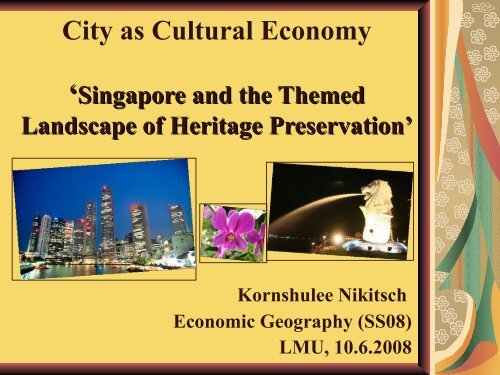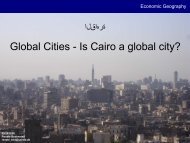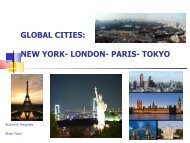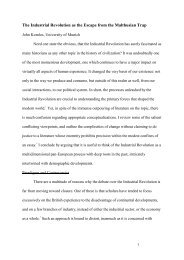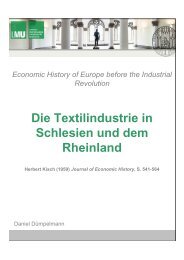City as Cultural Economy 'Singapore and the Themed Landscape of ...
City as Cultural Economy 'Singapore and the Themed Landscape of ...
City as Cultural Economy 'Singapore and the Themed Landscape of ...
You also want an ePaper? Increase the reach of your titles
YUMPU automatically turns print PDFs into web optimized ePapers that Google loves.
<strong>City</strong> <strong>as</strong> <strong>Cultural</strong> <strong>Economy</strong><br />
‘Singapore <strong>and</strong> <strong>the</strong> <strong>Themed</strong><br />
L<strong>and</strong>scape <strong>of</strong> Heritage Preservation’<br />
Kornshulee Nikitsch<br />
Economic Geography (SS08)<br />
LMU, 10.6.2008
Singapore <strong>and</strong> <strong>the</strong> <strong>Themed</strong><br />
L<strong>and</strong>scape <strong>of</strong> Heritage Preservation<br />
Definition <strong>of</strong> “<strong>Cultural</strong> <strong>Economy</strong>”<br />
Singapore <strong>and</strong> <strong>the</strong> <strong>Themed</strong> L<strong>and</strong>scape <strong>of</strong><br />
Heritage Preservation<br />
From Reconstructing <strong>the</strong> P<strong>as</strong>t to Making<br />
<strong>of</strong> a New Nation<br />
Heritage Mobilization for Urban<br />
Development<br />
New Asia-Singapore<br />
Conclusion
Definition <strong>of</strong> “<strong>Cultural</strong> <strong>Economy</strong>”<br />
“<strong>Cultural</strong> <strong>Economy</strong>” <strong>as</strong> goods <strong>and</strong><br />
services that are extremely<br />
heterogeneous in <strong>the</strong>ir substance,<br />
appearance, <strong>and</strong> sectoral origins,<br />
flowing from traditional<br />
manufacturing sectors engaged in <strong>the</strong><br />
transformation <strong>of</strong> physical inputs into<br />
final outputs<br />
Allen J. Scott
<strong>Cultural</strong> <strong>Economy</strong> Products…<br />
are made competitively marketable <strong>as</strong> modes <strong>of</strong> social display,<br />
forms <strong>of</strong> entertainment <strong>and</strong> distraction, or sources <strong>of</strong> information<br />
<strong>and</strong> self-awareness, i.e.<br />
Goods <strong>and</strong> services that involve some<br />
personalized transaction or <strong>the</strong><br />
production <strong>and</strong> transmission <strong>of</strong><br />
information, for example, tourist<br />
services, live <strong>the</strong>ater, or advertising<br />
A hybrid form, such <strong>as</strong> music recording,<br />
book publishing, or film production
<strong>City</strong> <strong>as</strong> <strong>Cultural</strong> <strong>Economy</strong><br />
Peter Hall (Cities in Civilization, 1998):<br />
“Cities have always played a privileged<br />
role <strong>as</strong> centers <strong>of</strong> cultural <strong>and</strong> economic<br />
activity. From <strong>the</strong>ir earliest origins, cities<br />
have exhibited a conspicuous capacity<br />
both to generate culture in <strong>the</strong> form <strong>of</strong><br />
arts, ide<strong>as</strong>, styles <strong>and</strong> ways <strong>of</strong> life, <strong>and</strong> to<br />
induce high levels <strong>of</strong> economic innovation<br />
<strong>and</strong> growth…”
Singapore <strong>and</strong> <strong>the</strong> <strong>Themed</strong> L<strong>and</strong>scape<br />
<strong>of</strong> Heritage Preservation<br />
From Reconstructing <strong>the</strong> P<strong>as</strong>t to Making <strong>of</strong><br />
a New Nation<br />
Building a “Nation” in a Modern <strong>City</strong>scape
Building a “Nation” in a Modern <strong>City</strong>scape<br />
Public housing l<strong>and</strong>scape through <strong>the</strong><br />
Housing <strong>and</strong> Development Board (HDB) <strong>as</strong><br />
<strong>the</strong> state’s most important tools for<br />
developing a modern city<br />
Housing-market regulatory mechanism to<br />
maintain particular goals, such <strong>as</strong> ensuring<br />
priority to particular types <strong>of</strong> family<br />
structures, particular mixes <strong>of</strong> races in<br />
estates, <strong>and</strong> particular orientation toward<br />
work
Recreating <strong>the</strong> P<strong>as</strong>t <strong>and</strong> Reconstructing <strong>the</strong> “Nation”:<br />
Heritage Mobilization for Urban Development<br />
5 Ms: State’s hegemonic ideologies <strong>of</strong><br />
multiracialism, multilingualism, multiculturalism,<br />
multireligiosity <strong>and</strong> meritocracy, in reconstructing<br />
<strong>the</strong> sense <strong>of</strong> <strong>the</strong> “Nation”<br />
Multiracializing <strong>the</strong> l<strong>and</strong>scape: <strong>the</strong> heritance <strong>of</strong><br />
street names <strong>and</strong> <strong>the</strong> rebuilding <strong>of</strong> ethnic quarters<br />
Streets naming to reflect <strong>the</strong> multilingual,<br />
multiracial <strong>and</strong> multicultural context <strong>of</strong> <strong>the</strong> society<br />
<strong>and</strong> be e<strong>as</strong>ily translated or pronounced in <strong>the</strong> o<strong>the</strong>r<br />
<strong>of</strong>ficial languages, namely English, M<strong>and</strong>arin,<br />
Malay <strong>and</strong> Tamil
Singapore <strong>as</strong> <strong>the</strong> “Tourism Capital”<br />
with Multiculturalism<br />
Singapore’s Five Categories <strong>of</strong> Heritage:<br />
The heritage <strong>of</strong> nationbuilding<br />
derived from<br />
<strong>and</strong> including <strong>the</strong><br />
experience <strong>of</strong> living<br />
under <strong>the</strong> British<br />
colonial<br />
administration, <strong>the</strong><br />
Japanese Occupation,<br />
<strong>the</strong> post-war struggle<br />
for independence, <strong>and</strong><br />
<strong>the</strong> struggle against<br />
Communism<br />
The heritage <strong>of</strong> economic<br />
success, focusing on <strong>the</strong><br />
values <strong>of</strong> Singapore’s<br />
migrant predecessors<br />
<strong>and</strong> <strong>the</strong>ir economic<br />
achievements
Singapore <strong>as</strong> <strong>the</strong> “Tourism Capital”<br />
with Multiculturalism<br />
Singapore’s Five Categories <strong>of</strong> Heritage:<br />
The multicultural heritage expressed in <strong>the</strong> lifestyles,<br />
customs <strong>and</strong> traditions <strong>of</strong> <strong>the</strong> different ethnic<br />
communities<br />
The heritage <strong>of</strong> <strong>the</strong> man-made environment comprising<br />
buildings, l<strong>and</strong>marks <strong>and</strong> o<strong>the</strong>r visible <strong>and</strong> tangible<br />
links to <strong>the</strong> country’s p<strong>as</strong>t in <strong>the</strong> physical l<strong>and</strong>scape<br />
The heritage <strong>of</strong> <strong>the</strong> natural<br />
environment, defining<br />
Singapore’s territorial<br />
identity <strong>and</strong> its location within<br />
<strong>the</strong> Sou<strong>the</strong><strong>as</strong>t Asian ecological<br />
region
Singapore <strong>as</strong> <strong>the</strong> “Tourism Capital”<br />
with Multiculturalism<br />
Heritage preservation <strong>as</strong> an element <strong>of</strong> multi-faceted<br />
redevelopment strategies designed to cater tourist<br />
dem<strong>and</strong>s for uniqueness <strong>and</strong> to improve urban<br />
aes<strong>the</strong>tics<br />
Thematic development through <strong>the</strong> Singapore<br />
Tourism Board (STB) transforming opportunity<br />
are<strong>as</strong> around suitable existing attractions into<br />
<strong>the</strong>matic zones<br />
Reformulation <strong>of</strong> <strong>the</strong> city’s cultural products to make<br />
Singapore a destination for memorable experiences<br />
by integrating activity clusters, services, facilities <strong>and</strong><br />
street furniture in historic are<strong>as</strong> into a single <strong>the</strong>med<br />
development
Examples <strong>of</strong> Dynamics <strong>and</strong> Politics in <strong>the</strong><br />
Shaping <strong>of</strong> Heritage L<strong>and</strong>scapes in Singapore<br />
Chinatown: The Politics<br />
<strong>of</strong> Reinvention<br />
Kampong Glam: The<br />
Politics <strong>of</strong> Exclusion<br />
The Merlion: Monument<br />
<strong>and</strong> Myth
Chinatown: The Politics <strong>of</strong> Reinvention<br />
Singapore <strong>as</strong> new Asia, a city <strong>of</strong><br />
many colors <strong>and</strong> contr<strong>as</strong>ts,<br />
cultures <strong>and</strong> cuisines<br />
Traditional shophouses<br />
refurbished for<br />
business purposes
Kampong Glam: The Politics <strong>of</strong><br />
Exclusion<br />
The demarcation between<br />
conservation <strong>and</strong> demolition <strong>of</strong> <strong>the</strong><br />
Malay heritage<br />
The reinterpretation <strong>and</strong> reinvention<br />
<strong>of</strong> state-envisioned <strong>of</strong> Malay heritage<br />
<strong>as</strong> pieces <strong>of</strong> life <strong>and</strong> l<strong>and</strong>scape that can<br />
be objectified, isolated <strong>and</strong> displayed<br />
according to aes<strong>the</strong>tic <strong>and</strong> political<br />
st<strong>and</strong>ards
The Merlion: Monument <strong>and</strong> Myth<br />
Merlion <strong>as</strong> a self-consciously styled<br />
attraction created for <strong>the</strong> express<br />
purpose <strong>of</strong> forging a tourism image<br />
<strong>and</strong> a part <strong>of</strong> rarefied objects<br />
tourists insist on seeing,<br />
photographing, <strong>and</strong> purch<strong>as</strong>ing <strong>as</strong><br />
pro<strong>of</strong> <strong>of</strong> <strong>the</strong>ir having experienced<br />
Singapore<br />
The Merlion, a “half<br />
be<strong>as</strong>t, half fish” <strong>as</strong> an<br />
iconographic feature <strong>of</strong><br />
Singapore’s l<strong>and</strong>scape<br />
reflecting <strong>the</strong> quest for<br />
national symbol
New Asia-Singapore<br />
The Esplanade-Theater on <strong>the</strong> Singapore Bay to<br />
promote Singapore <strong>as</strong> a global city for <strong>the</strong> arts with<br />
multicultural Asian roots<br />
<strong>City</strong> br<strong>and</strong>ing against o<strong>the</strong>r cities in <strong>the</strong> region
Conclusion<br />
Symbiosis <strong>of</strong> place,<br />
culture <strong>and</strong> economy in<br />
modern capitalism<br />
reemerging in powerful<br />
new forms <strong>as</strong> cultural<br />
economies in certain<br />
countries<br />
The “Uniquely<br />
Singapore” <strong>as</strong> social<br />
<strong>and</strong> spatial construct <strong>of</strong><br />
a nation on <strong>the</strong> <strong>the</strong>med<br />
l<strong>and</strong>scape <strong>of</strong> heritage<br />
preservation
Thank You<br />
For Your Attention
References<br />
Hall, Peter G. 1998. Cities in Civilization. New York, Pan<strong>the</strong>on.<br />
Kong, Lily, <strong>and</strong> Brenda S. A. Yeoh. 2003. The Politics <strong>of</strong><br />
L<strong>and</strong>scape in Singapore: Constructions <strong>of</strong> ‘Nation’. New York:<br />
Syracuse University Press.<br />
Low, Linda <strong>and</strong> Toh Mun Heng. 1997. “Singapore:<br />
Development <strong>of</strong> Gateway Tourism.” In Tourism Development<br />
in Asia <strong>and</strong> Austral<strong>as</strong>ia, edited by Frank M. Go <strong>and</strong> Carson L.<br />
Jenkins, 237-254. London: A C<strong>as</strong>ell Imprint.<br />
Perry, Martin, Lily Kong <strong>and</strong> Brenda Yeoh. 1997. Singapore:<br />
A Developmental <strong>City</strong> State. Chichester: John Wiley.<br />
Scott, Allen J. 2006. Geography <strong>and</strong> <strong>Economy</strong>. Oxford:<br />
Clarendon Press.<br />
Scott, Allen J. 2000. The <strong>Cultural</strong> <strong>Economy</strong> <strong>of</strong> Cities. London:<br />
Sage Publications.<br />
Zukin, Sharon. 1991. L<strong>and</strong>scapes <strong>of</strong> Power: From Detroit to<br />
Disney World. Berkley: University <strong>of</strong> California.


